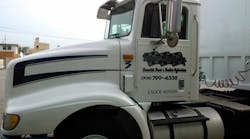President: Dave Letts
Company: Transport Finishes Inc.
Operation: A sandblasting, body work, fiberglass repair, and paint shop for heavy-duty trucks and trailers located in East Hazel Crest, IL
PROBLEM:
When it comes to refurbishing trailers, Dave Letts says that corrosion problems strike the same areas over and over again largely due to the operating conditions every trucking company must deal with.
“Any forward-facing surface under the trailer is at higher risk, and the closer the proximity to a tire, the higher the probability of corrosion,” says Letts, president of Transport Finishes.
He explains that forward-facing crossbars on trailer landing gear take a lot of abuse from rock strikes and the spray of moisture kicked up by tires—moisture that, in the winter, often contains high amounts of liquid calcium chloride used to keep roadways clear of snow and ice. The rock strikes, of course, chip off the paint protecting trailer components, thus exposing them to corrosion.
“Bogie assemblies are equally susceptible, as are the structural cross members just above and behind them,” Letts explains, with anything below a “spray line” of about 8 to 10 ft. susceptible to corrosion.
Inspections, of course, can find corrosion but not stop it. So how, in the course of the company’s refurbishment work, could anti-corrosion protection be added?
SOLUTION:
Letts hit upon protective wax compounds developed by Chicago-based Daubert Chemical Co. called Nox-Rust 1210HP and Nox-Rust X-121B, which are corrosion-inhibiting materials for medium- and heavy-duty trucks as well as trailers.
Both contain rust-inhibiting chemicals and are “hydrophobic,” meaning they literally exclude water molecules from making contact with the metal they cover, while also protecting metal components from salt, humidity, dirt, and debris.
Nox-Rust X-121B is available in an aerosol can for touch-up applications and in industrial quantities that can be applied to larger areas using low-pressure airless equipment.
Letts stresses that the key to using such waxes is understanding the type of corrosion-fighting materials originally applied; for example, when making repairs, some coatings and materials are harder and more costly than others to work with.
The benefit of wax-based coatings is that they are soft, pliable and self-healing even when struck by rocks or dinged by “abrasion,” such as if a trailer bumps a dock too hard. Because of its malleability, Letts says the material won’t chip and essentially encapsulates a metal substrate in a protective coating that is much better suited to the wet abrasive environments found under a heavy-duty commercial trailer.
Daubert recently conducted several comparative corrosion-resistance tests following the Association for Testing and Materials International (ASTM) B117 standards. He found that after 1,000 hours of exposure to a saline spray, a galvanized steel I-beam began visibly shedding its protective zinc coating in the form of zinc oxide, also known as “white rust,” while a similar I-beam coated with Nox-Rust 1210HP wax did not.
Still, Transport’s Letts stresses that the key to improved corrosion resistance is to incorporate corrosion detection into a formal preventive maintenance protocol.
“Even something as simple as choosing the wrong nut, bolt and washer, if made from dissimilar metals, can trigger a corrosive reaction when tightening fasteners dislodges surface coatings, exposing the metals to one another,” he says. “If they know what to look for and where, maintenance professionals can often locate trouble spots and remediate corrosion before it gains a foothold.



